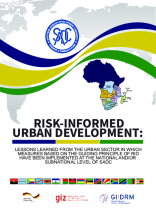Africa’s cities face exponential growth with unplanned urbanization trends and unfolding vulnerabilities threatening to undo SADC’s urban development gains and increasing inequality thereby the exposure of majority of the population to disaster risks and ultimately their vulnerability to disasters. The rapid urban transformation has meant that African cities have seen an exponential urban population growth from approximately 70 million in 1970 to 294 million in 2010 and is projected to reach 621 million by 2030 and, will almost double to 1.2 billion by 2050. This trend can also be observed in the region represented by the SADC. In fact, SADC’s 16 Member States are among the world’s fastest urbanizing countries. Unprecedented urbanisation is arguably the most significant transformation that African countries will experience this century, and which presents both challenges and opportunities, inclusive of the rise of urban disaster risk. Despite Africa’s low contribution to GHG emissions, the continent remains the most vulnerable to hazards and risk drivers like climate change and climate variability.
The significantly large urban population and future projections directly correlate to the exposure and experience of disaster losses. Due to a lack of local capacity and financial means to manage this rapid urban growth, much of the urban expansion has Statement of Purpose Development is taking place in a complex and uncertain environment of risks – at the same time current development pathways are creating risk faster than we can manage risk. Risk needs to be understood as being interdependent and systemic. Disaster risk reduction is not enough – we need to transform our development pathways to risk-informed development. Building capacities and promoting an enabling environment to make decisions risk-informed is key. Fostering the participation of all members of society and systemically addressing inequalities are cornerstones of risk-informed development.
There is no universal blueprint – risk-informed development needs to be tailored to the context with sufficient flexibility to re-evaluate and adapt continuously. Riskinformed decision-making is a prerequisite for sustainable development and fundamental to preventing the creation of risk. Based the integration of Risk-informed Development-Based (RID) processes at the SADC national and/or subnational levels and in conjunction with other German technical cooperation projects; this report synthesizes the lessons learned drawn from the urban sector. The report provides a summary of the lessons learned for RIUD under five main clusters namely: 1) Legal & organizational setups; 2) Programmatic and actionable setups; 3) Budget & Funding; 4) Risk Assessment & Mitigation options and; 5) Data & Information flows and presents ad series of recommendations for further exchange and consideration. An overview of expert input and still online accessible sessions along the LEP and the Making Cities Resilient 2030 Roadmap (MCR2030) is provided. been taking place outside or in the absence of formal planning frameworks compliant with domestic ordinances and by-laws. Urban sprawl is a common experience among settlements across the continent, characterized by the creation of high vulnerability thereby high disaster risk due to poor living conditions with a lack of basic and social services. While Disaster Risk Reduction (DRR) has become an important topic on the SADC agenda, research reveal that the urban dimension of risks is still insufficiently reflected in the overall package of institutional, organizational competences and capacities throughout the SADC, its Member States (MS) and the Local Governments

